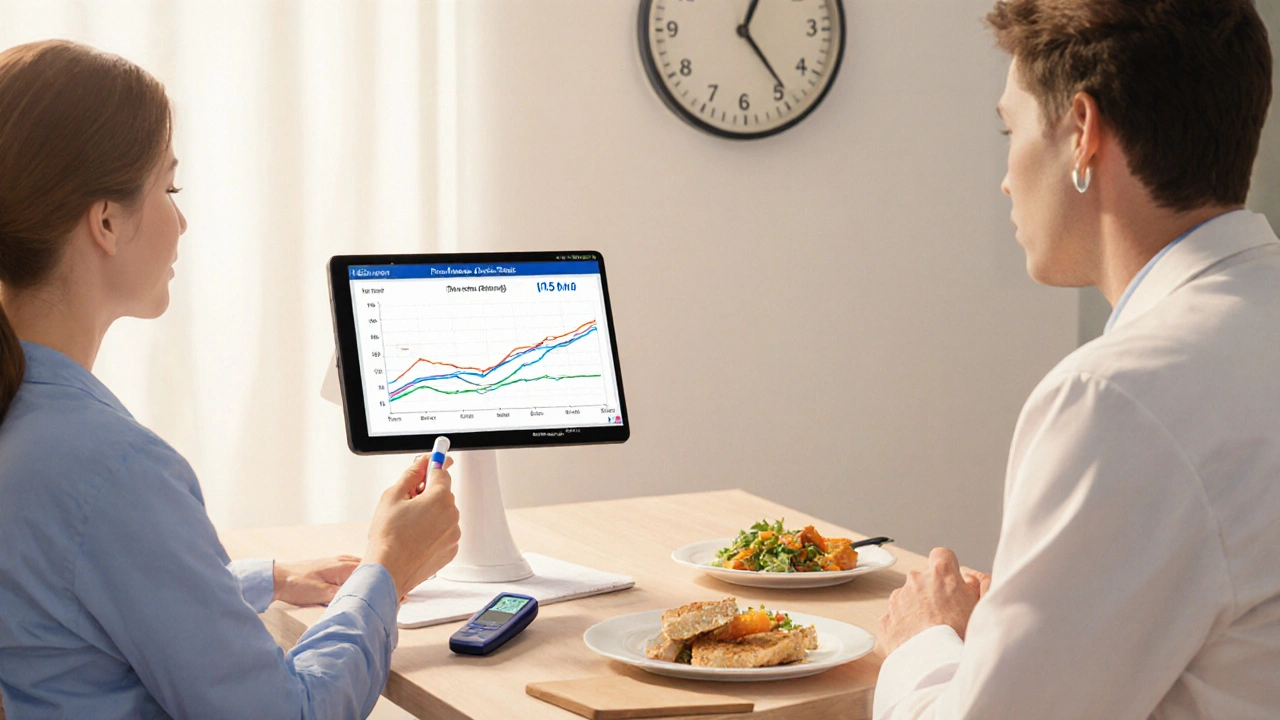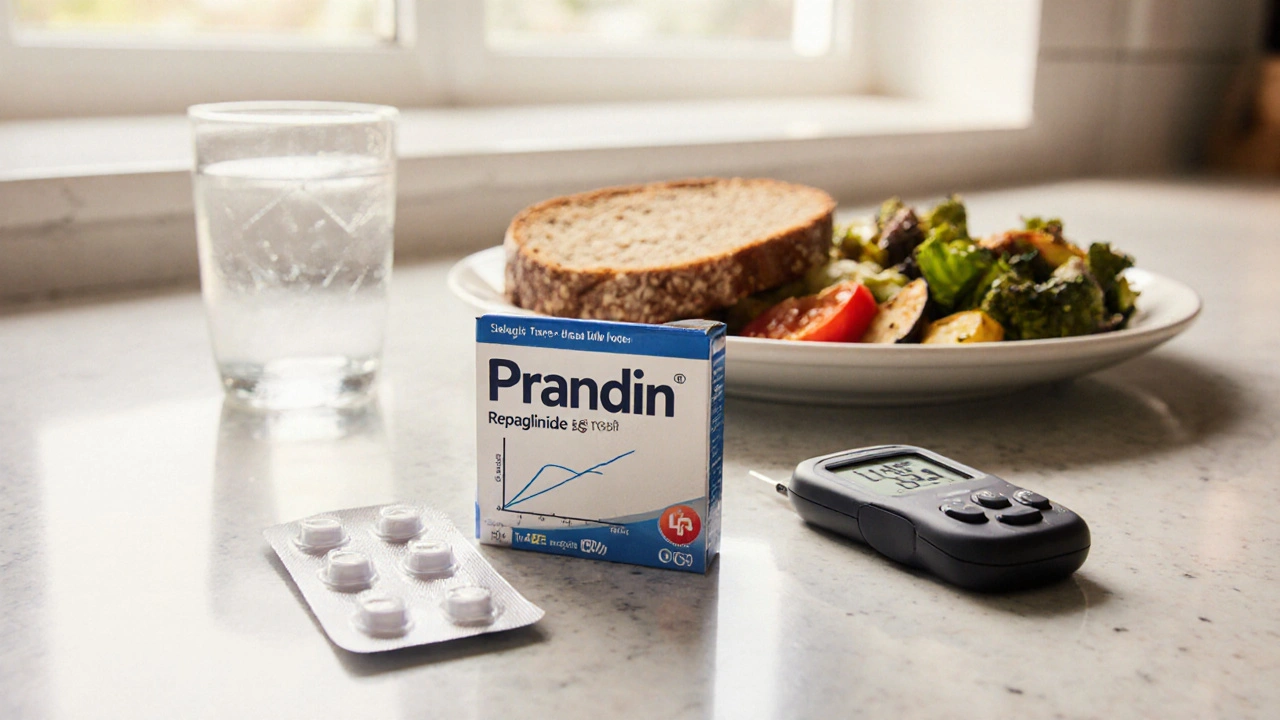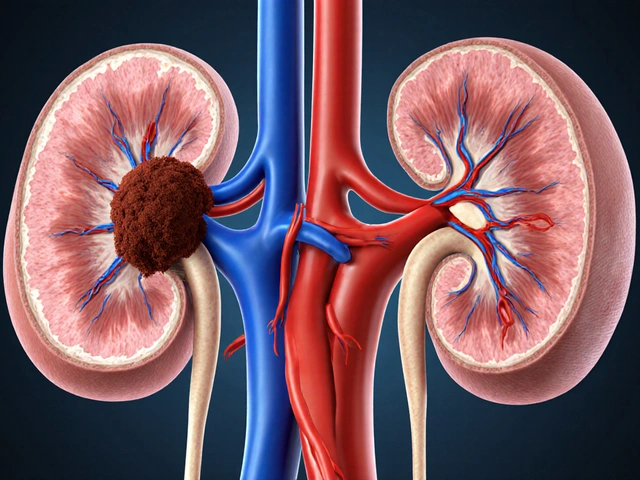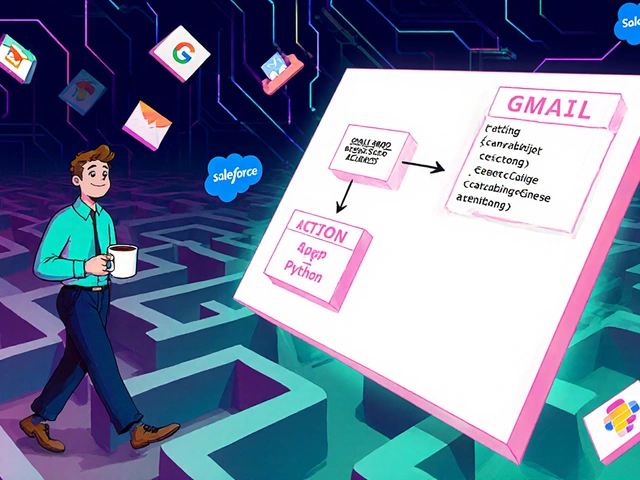Prandin vs Diabetes Medications Comparison Tool
Recommended Medication Options
When it comes to controlling blood sugar in type 2 diabetes, Prandin is a brand name for repaglinide, a fast‑acting oral agent that belongs to the meglitinide class. It’s often prescribed for people who need quick drops in post‑meal glucose but can’t tolerate or don’t want to use injectable drugs.
Key Takeaways
- Prandin works by stimulating quick insulin release, making it ideal for managing post‑prandial spikes.
- Its main rivals are other meglitinides, sulfonylureas, metformin, DPP‑4 inhibitors, GLP‑1 agonists, and SGLT2 inhibitors.
- Compared with sulfonylureas, Prandin has a lower risk of prolonged hypoglycaemia but requires meals on schedule.
- Cost and dosing frequency often tip the balance between Prandin and alternatives like metformin or newer agents.
- Choosing the right medication hinges on kidney function, weight goals, hypoglycaemia history, and insurance coverage.
What is Prandin (Repaglinide)?
Repaglinide is a meglitinide that binds to the same potassium channels on pancreatic beta‑cells as sulfonylureas, prompting a rapid burst of insulin. Unlike long‑acting sulfonylureas, its effect peaks within 30‑60 minutes and fades after about 4‑6 hours, which mirrors the timing of a typical meal.
The usual dose is 0.5-2mg taken 15 minutes before each main meal, with a maximum of 6mg per day. Because it’s cleared mainly by the liver, dose adjustments are rarely needed for mild renal impairment, but severe liver disease does require caution.
How Repaglinide Works and Who Benefits Most
By closing ATP‑sensitive potassium channels, repaglinide triggers depolarisation of beta‑cells, calcium influx, and insulin release. The rapid onset means it can target the post‑prandial glucose rise, which is especially useful for:
- Patients with irregular meal patterns who need flexibility.
- Those who have experienced nocturnal hypoglycaemia on long‑acting sulfonylureas.
- Individuals whose HbA1c is primarily driven by post‑meal spikes (often >1.5% above target).
The drug does not improve fasting glucose much, so it’s usually combined with a basal agent like metformin or a GLP‑1 agonist for comprehensive control.
Key Alternatives to Prandin
Below are the most common drugs that patients compare against repaglinide.
- Metformin - a first‑line biguanide that lowers hepatic glucose production and improves insulin sensitivity. It’s inexpensive, weight‑neutral, and has a long safety record.
- Glipizide - a sulfonylurea with a slightly longer duration than repaglinide, often taken once or twice daily. It carries a higher risk of prolonged hypoglycaemia.
- Nateglinide - another meglitinide similar to repaglinide but with a slightly shorter half‑life, making it useful for patients who eat very small, frequent meals.
- Sitagliptin - a DPP‑4 inhibitor that boosts endogenous incretin levels, providing modest HbA1c reduction with very low hypoglycaemia risk.
- Liraglutide - a GLP‑1 receptor agonist delivered by injection; it lowers both fasting and post‑prandial glucose, promotes weight loss, and reduces cardiovascular events.
- Empagliflozin - an SGLT2 inhibitor that increases urinary glucose excretion, offering modest weight loss and cardiovascular protection, but can cause genital infections.
Comparison Table: Prandin vs Common Alternatives
| Drug | Class | Typical Dose | HbA1c Reduction | Weight Effect | Hypoglycaemia Risk | Cost (UK) |
|---|---|---|---|---|---|---|
| Prandin (repaglinide) | Meglitinide | 0.5‑2mg ×3doses | 0.8‑1.2% | Neutral | Low (meal‑dependent) | £30‑£45/month |
| Metformin | Biguanide | 500‑1000mg BID | 1.0‑1.5% | Neutral to modest loss | Very low | £5‑£15/month |
| Glipizide | Sulfonylurea | 5‑10mg QD | 0.5‑1.0% | Neutral | Medium‑high | £10‑£20/month |
| Sitagliptin | DPP‑4 inhibitor | 100mg QD | 0.5‑0.8% | Neutral | Very low | £30‑£40/month |
| Liraglutide | GLP‑1 agonist | 0.6‑1.8mg QD (inj.) | 1.0‑1.5% | Weight loss (≈3kg) | Low | £250‑£300/month |
| Empagliflozin | SGLT2 inhibitor | 10‑25mg QD | 0.5‑0.7% | Weight loss (≈2kg) | Low | £70‑£90/month |
Decision Criteria: When to Choose Prandin
Use the following checklist to see if repaglinide fits your situation:
- Meal timing matters: If you eat at irregular intervals or have a variable schedule, the rapid‑onset, short‑duration profile is advantageous.
- Risk of hypoglycaemia: For patients who have struggled with prolonged lows on sulfonylureas, Prandin’s glucose‑dependent action reduces that danger.
- Liver function: Since the drug is metabolised hepatically, mild‑to‑moderate liver disease may need dose tweaks, whereas severe renal impairment is less of a concern.
- Cost considerations: It sits in the mid‑range of oral agents; if budget is tight, metformin remains cheaper.
- Weight goals: Prandin is weight‑neutral, making it a neutral choice if weight loss isn’t a priority.
- Combination therapy: Pairing with metformin or a GLP‑1 agonist can cover both fasting and post‑prandial glucose.
Prandin vs Specific Alternatives: Quick Scenarios
Scenario 1 - You’re already on metformin but HbA1c stays high because of post‑meal spikes. Adding Prandin targets the exact problem without increasing overall hypoglycaemia risk.
Scenario 2 - You experience nighttime lows on glipizide. Switching to Prandin removes the long‑acting sulfonylurea effect, so lows only happen when a meal is missed.
Scenario 3 - You want to avoid injections but need stronger control than metformin alone. Repaglinide plus metformin can give a two‑pronged approach without the need for GLP‑1 injections.
Scenario 4 - You have chronic kidney disease (eGFR<30mL/min). Metformin dose must be reduced; Prandin remains usable, but a DPP‑4 inhibitor like sitagliptin may be safer because it doesn’t rely on renal clearance.
Potential Side Effects and How to Manage Them
Common issues with repaglinide include mild nausea, headache, and occasional dizziness. The most serious concern is hypoglycaemia, especially if a dose is taken without a carbohydrate‑rich meal. Strategies to minimise risk:
- Always take the tablet 15minutes before eating.
- If a meal is skipped, omit the dose and monitor glucose closely.
- Carry fast‑acting glucose (e.g., glucose tablets) when you first start the medication.
Renal or hepatic impairment doesn’t drastically change side‑effect profile, but regular liver function tests are advisable after the first three months.

Cost and Availability in the UK
Prandin is available as a branded tablet and as a generic repaglinide. The NHS typically covers the generic version for patients meeting clinical criteria, while private prescriptions can be more expensive. Comparing costs:
- Generic repaglinide: £30‑£45 per month.
- Metformin: £5‑£15 per month (widely subsidised).
- Newer agents (GLP‑1, SGLT2): £70‑£300 per month, often needing special approval.
When budgeting, factor in the need for glucose monitoring supplies, which are modest for oral agents but higher for injectables.
How to Start Prandin Safely
- Discuss your current medication list with your GP or diabetes specialist.
- Confirm liver function tests are within normal limits.
- Begin with 0.5mg before your largest meal of the day.
- Measure fasting and post‑meal glucose for one week.
- If target reduction isn’t reached, increase dose by 0.5mg increments up to 2mg per meal, not exceeding 6mg total.
- Re‑evaluate HbA1c after 12 weeks; adjust combination therapy if needed.
Regular follow‑up appointments ensure the dose stays optimal and side effects are caught early.
Frequently Asked Questions
Frequently Asked Questions
Is Prandin safe for people with type 1 diabetes?
Prandin stimulates insulin release from functioning beta‑cells, which are absent or severely depleted in type1 diabetes. Therefore it is not recommended for type1 patients.
Can I take Prandin with metformin?
Yes. The combination is common because metformin controls fasting glucose while repaglinide handles post‑prandial spikes. Start metformin first, then add Prandin after a few weeks.
How quickly does repaglinide lower blood sugar?
Peak insulin release occurs within 30‑60minutes, and glucose levels usually drop by 30‑40mg/dL within two hours after a meal.
What should I do if I miss a meal after taking Prandin?
Skip the dose. Because the drug’s effect fades after a few hours, taking it without food raises the chance of hypoglycaemia.
Is there a generic version of Prandin?
Yes. Generic repaglinide contains the same active ingredient and is approved by the MHRA. It offers the same efficacy at a lower price.
If you’re still unsure which medication suits you best, schedule a check‑up with your diabetes care team. They can run the numbers, factor in your personal health history, and help you pick the right mix of drugs - whether that’s Prandin, metformin, or a newer class.
repaglinide comparison is a common search term because patients want to see side‑by‑side data. This guide provides exactly that, plus practical steps to start, monitor, and adjust therapy safely.







Comments
Rex Peterson
October 9, 2025 AT 22:10 PMWhen one evaluates the therapeutic landscape for type 2 diabetes, it is prudent to consider not only glycaemic efficacy but also the philosophical dimensions of patient autonomy and lifestyle compatibility. The rapid‑acting nature of repaglinide aligns with a patient’s desire for temporal freedom, yet it demands a disciplined mealtime regimen. In this dialectic, the abstract notion of control meets the concrete reality of pharmacokinetics, producing a synthesis that may be preferable for those whose daily routines are erratic.
Candace Jones
October 9, 2025 AT 23:33 PMHey folks! If you’ve got a hectic schedule, Prandin can be a real lifesaver – just pop it before meals and you’ll dodge those post‑lunch spikes. It’s a solid option when you want something quick without the hassle of injections, and the cost sits nicely in the middle range. Give it a try and see how your energy levels stay steady throughout the day.
Robert Ortega
October 10, 2025 AT 00:56 AMLooking at the table, the trade‑offs are fairly balanced. Metformin wins on cost and fasting glucose, while Prandin shines for post‑prandial control without lingering hypoglycaemia. For someone who eats on the go, the short‑acting profile makes sense. It’s ultimately a matter of matching the drug’s kinetic profile to personal habits.
Elizabeth Nisbet
October 10, 2025 AT 02:20 AMJust a quick tip: combine a basal agent like metformin with Prandin if you’re still seeing high fasting numbers. The combo covers both ends – basal and mealtime spikes – without adding a lot of weight gain risk. Keep an eye on your HbA1c and adjust doses gradually.
Sydney Tammarine
October 10, 2025 AT 03:43 AMHonestly, the so‑called "modern" drugs are just overpriced hype 🙄. Prandin’s modest price and swift action make it the hero of the forgotten masses, while those pricey GLP‑1 injections are for the elite who love flashing their wallets. #StayReal 😊
josue rosa
October 10, 2025 AT 05:06 AMFrom a pharmacodynamic perspective, repaglinide occupies the sulfonylurea receptor with a rapid onset and a notably brief half‑life, thereby eliciting a pulsatile insulin release that closely mimics physiologic post‑prandial secretion. This kinetic profile confers a distinct advantage in mitigating prolonged hypoglycaemic episodes, particularly in patients with irregular meal patterns who cannot adhere to the fixed dosing schedules imposed by longer‑acting sulfonylureas. Moreover, hepatic metabolism via CYP3A4 and CYP2C8 pathways ensures that renally impaired individuals experience a reduced risk of accumulation, a salient consideration given the prevalence of diabetic nephropathy. Clinical trials have demonstrated an average HbA1c reduction of approximately 1.0 % when repaglinide is employed as adjunct therapy to metformin, illustrating its synergistic potential. In comparison to DPP‑4 inhibitors, which provide modest glycaemic improvements with negligible hypoglycaemia risk, repaglinide offers a more robust post‑prandial effect at the expense of a modestly higher hypoglycaemic propensity, albeit still inferior to traditional sulfonylureas. The cost‑effectiveness ratio is favourable; while not as inexpensive as metformin, it remains substantially more accessible than injectable GLP‑1 agonists or SGLT2 inhibitors, positioning it as a pragmatic middle ground. Patient adherence is further enhanced by the convenience of oral administration and the flexibility of dosing relative to meal timing, a characteristic that aligns well with contemporary lifestyle demands. Nonetheless, clinicians must counsel patients regarding the necessity of consistent meal intake to avoid inadvertent hypoglycaemia, and routine monitoring of hepatic function is advisable. In summary, repaglinide occupies a niche wherein it offers rapid, meal‑triggered insulin secretion, moderate HbA1c reduction, acceptable safety, and economic viability, making it a compelling option for individualized diabetes management strategies.
Shawn Simms
October 10, 2025 AT 06:30 AMWhile the data presented appears comprehensive, I would recommend verifying the numerical ranges for HbA1c reduction; the dash‑separated format can be ambiguous. Additionally, ensure consistent use of the Oxford comma throughout the list items for grammatical precision.
Geneva Angeles
October 10, 2025 AT 07:53 AMAlright, team! If you’re battling those stubborn post‑meal spikes, Prandin is your secret weapon. It doesn’t cost a fortune, and you’ll feel more energized after meals. Pair it with a healthy diet and you’ll see the numbers drop faster than a roller‑coaster. Keep pushing forward – you got this!
Scott Shubitz
October 10, 2025 AT 09:16 AMLet’s cut to the chase: the pharmaceutical circus loves to push the newest shiny thing, but the real MVP is that cheap, fast‑acting tablet that actually works when you need it. If you’re tired of pharmaceutical snake oil, give repaglinide a whirl – it’s the underdog that punches above its weight class.
Drew Chislett
October 10, 2025 AT 10:40 AMGood point, Elizabeth! Combining basal metformin with a quick‑acting agent like Prandin really does cover both the fasting and post‑prandial fronts. It’s a strategy that many clinicians overlook, but it can be a game‑changer for patients with mixed glucose patterns.
Rosalee Lance
October 10, 2025 AT 12:03 PMOne could argue that the prevailing narrative around newer agents overshadows the practical benefits of repaglinide. It’s essential to remember that simplicity often translates to better adherence, and the data supports its efficacy without the exuberant marketing hype.
Kara Lippa
October 10, 2025 AT 13:26 PMI appreciate the balanced overview. It’s helpful to see both the clinical and financial aspects laid out clearly, especially for patients navigating insurance hurdles.
Puneet Kumar
October 10, 2025 AT 14:50 PMFrom a global health perspective, repaglinide offers a viable option for low‑resource settings where injectable therapies are less feasible. Its oral formulation and moderate cost facilitate broader accessibility while maintaining clinical efficacy.
michael maynard
October 10, 2025 AT 16:13 PMHonestly, the whole “new drug” craze is just a ploy by Big Pharma to keep us dependent. They throw in fancy acronyms and sky‑high prices while the tried‑and‑true repaglinide sits quietly doing its job. Don’t be fooled.
Roger Bernat Escolà
October 10, 2025 AT 17:36 PMNice breakdown! Simple language, clear points – exactly what we need.
Allison Metzner
October 10, 2025 AT 19:00 PMEveryone’s talking about GLP‑1s like they’re the only answer, but don’t forget that the “real” pharma agenda is hiding behind those headlines. Keep your eyes open.
william smith
October 10, 2025 AT 20:23 PMGood summary.
Timothy Javins
October 10, 2025 AT 21:46 PMInteresting take, but I’d argue that any single drug can’t be a silver bullet; lifestyle factors still dominate outcomes.
Kay Yang
October 10, 2025 AT 23:10 PMNice work! The table makes it easy to compare at a glance. 😊
Rajesh Kumar Batham
October 11, 2025 AT 00:33 AM👍 Great info! Repaglinide looks like a solid choice for those with unpredictable meals.